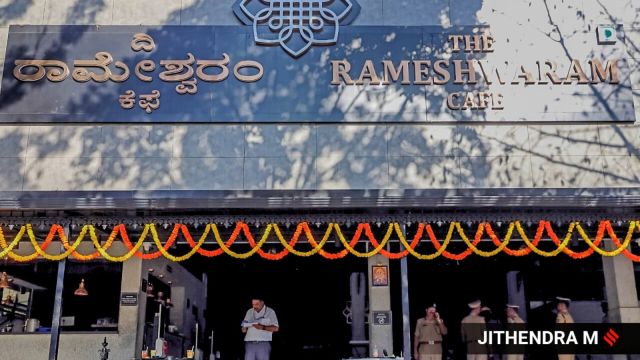2 Karnataka terror cases from 2022 back in focus following Rameshwaram Cafe blast
Investigators from multiple agencies are attempting to establish the identity of a young man caught on CCTV footage
 The three cases from 2022, including two terrorism cases, registered in the Mangaluru and Shivamogga regions of Karnataka, have gained prominence on account of the IED that was used in the Bengaluru incident. (Express File Photo)
The three cases from 2022, including two terrorism cases, registered in the Mangaluru and Shivamogga regions of Karnataka, have gained prominence on account of the IED that was used in the Bengaluru incident. (Express File Photo)A bunch of cases recorded in Karnataka in 2022 involving a group of 10 youths has come back into focus in the backdrop of the March 1 lunch hour bomb blast at the popular Rameshwaram Cafe in the Whitefield area of Bengaluru that left nine people injured.
Investigators from multiple agencies are attempting to establish the identity of a young man caught on CCTV footage – wearing a cap, glasses, and a mask – and identified as the suspect in the cafe blast, by talking to undertrials arrested in the 2022 cases who are lodged in the Bengaluru central prison.
The three cases from 2022, including two terrorism cases, registered in the Mangaluru and Shivamogga regions of Karnataka, have gained prominence on account of the IED that was used in the Bengaluru incident.
“There are similarities (with the Mangaluru and Shivamogga cases) in the sense that they have used similar materials and a similar system technically. Apart from that, we do not know,” Karnataka Home Minister G Parameshwara said on Sunday.
Sources familiar with the technical aspects of the investigations in the 2022 Mangaluru case – wherein an IED exploded accidentally while being carried by Mohammed Shariq, 24, a former BCom student (allegedly inspired by the ideology of the Islamic State terror group) –said the detonation system, including the timer and shrapnel like bolts, in the IEDs in Mangaluru and Bengaluru appeared to be the same.
The technical signatures of IEDs are considered to offer leads in investigations of blast cases and are often used as a preliminary guide to ascertain the identity of the group involved.
The presence of a group of youths allied to IS ideology and attempting to learn to make IEDs on their own with video coaching provided on encrypted communication platforms first emerged in 2022 when the Shivamogga police were investigating a stabbing incident.
A key suspect in the case, Mohammed Zabiullah, 23, was found to have received messages on encrypted applications on the IS and its ideology, from Mohammed Shariq, 24, the suspect who was eventually caught in Mangaluru on November 19, 2022.
The Shivamogga police probe revealed that Shariq and two associates, Maaz Muneer, 24, and Syed Yasin, 23, had constructed IEDs on the basis of coaching provided by Shariq and had tested them in the Shivamogga region.
The Shivamogga police arrested Muneer and Yasin on September 19, 2022, while Shariq remained absconding until he popped up in Mangaluru in November 2022 and was involved in an accidental blast in an auto-rickshaw that left him with 40 per cent burns.
Incidentally, Shariq, Muneer, and Yasin had been arrested earlier in 2021 in Mangaluru for painting provocative graffiti on the wall of a police station in the city.
After the Mangaluru IED blast in November 2022, the two bomb cases from Mangaluru and Shivamogga were taken over by the NIA. The agency has now named 10 people as accused in the Shivamogga trial bomb blast case and two people – Mohammed Shariq and Syed Yasin – in the Mangaluru blast case.
The 10 people accused by the NIA in the Shivamogga trial blast case are Mohammed Shariq, 24, Maaz Muneer Ahmed, 24, Syed Yasin, 23, Reeshan Tajuddin Sheikh, 24, Huzair Farhan Baig, 22, Mazin Abdul Rahman, 22, Nadeem Ahmed, 22, Mohammed Zabilulla, 23, Mohammed Faizal, 22, and Arafath Ali, 22.
Two people from Karnataka – Abdul Matheen Taha and Musabir Hussain Shakeb – are accused of being key handlers of the group and are yet to be apprehended. One of the 10 accused who have already been arrested, Arafath Ali – an alleged financier for the group – was brought back from the UAE in 2023 and was placed under arrest on September 15, 2023.
The two missing persons, Abdul Matheen Taha and Musabir Hussain, were first named in a police case in Bengaluru in 2020 by the local police for the creation of an ISIS-inspired terrorist gang called the Al Hind group with members from Kerala, Tamil Nadu, and Karnataka. The ISIS case in 2020 was a fallout of an investigation by the Tamil Nadu Police into the activities of an alleged Islamic State-linked radical, Khaja Moideen, 54.
The NIA in its probe since taking over the 2022 Shivamogga and Mangaluru bomb-linked cases has reported that Mohammed Shariq, Maaz Muneer, Syed Yasin, and Arafath Ali were in contact with an online handler named ‘Colonel’ to carry out terrorist activities. The identity of the person who went by the ‘Colonel’ pseudonym is yet to be established.
The NIA has alleged that one of the 10 accused in the Shivamogga case, Huzair Farhan Baig, arranged a hideout in Bengaluru for Maaz Muneer out of funds received through crypto wallets “to extend the activities of Islamic State to Bengaluru”.







